Stop Asian Hate;0
In a world where people fear for their safety. That’s so broad that it can be anybody considering how society is now. Specifically though, asian hate is something that has been increasing and has become a concern to many asian artists. Due to covid-19 asian hate crime has been more severe and musicians have unfortunately suffered the consequences. That didn’t stop them from making a change by being a voice that wasn’t left unheard. We need to inform people what really is occurring behind the scenes to truly stop asian hate crimes happening to pleanty of people around the world.
Asian hate, what really is it and why is it going on? Asian hate basically is when people go out of their way to verbally and or physically abuse the asian community. In one article “I Still Believe In Our City” it states”NYC hospitals saw a spike of nearly 200,000 patients, Asian and Pacific Islanders (APIs) faced an added threat: blame, racism, and xenophobia” this shows that the increase of covid-19 patient the more dangerouse Asian lives will be at risk. Many people believe that China started covid on purpose to hurt the Americans this alleged accusation affecting the whole asian community. This is all causing many people from discriminating against them and intentionally causing harm.
In the article “Anti-Asian hate crimes rose to 73% since 2020” it states “ Anti-Asian hate crimes increased more than 73 percent in 2020, according to newly corrected FBI data”
The time period of this article as well matches with the timeline of the Covid-19, this just proves my point and the severity of asian hate as the crime rate is over 50% and which is still rising till 2021.
The asian community with the tender and loving heart they have they continue trying to battle this societal conflict with music bringing peace but even then people continue with their heartless acts. In San Francisco there is a violinist with the name of David Kim. A talented person who would play classical music to bring people together but yet still would get disturbed by racism in his own music community. An article named “Asians Are Represented in Classical Music. But Are They Seen?” written by the New York Times it states “he felt his white colleagues in San Francisco, who make up 83 percent of the orchestra, did not share his urgency about building a culture more welcoming to Asian, Black and Latino players.” This demonstrating that even with his peers knowing his background are yet not supportive to make him feel welcomed into the orchestra. Later in that article kin himself stated “I felt invisible, even though I was speaking very loudly,” Music being a passion for Mr kim but still didn’t feel comfortable or welcomed
Another famous artist based in New York city Amanda Phingbodhipakkiya , she has made many art works to stop the asian hate, you can see all of her work through subways, buses, and streets from graffiti, posters and even quilted artwork. She has said she once was about to sit down in the subway somebody said” ew gross get away from me” this just demonstrates how bad this asian hate has become.
Asian hate is getting out of control after the covid 19,not only toward older people but also on younger populations. and that NEEDs to be fixed. Many Asian elderly women would get hurt for that reason. Some would get robbed, stealing their purse, and hurting them, in the worst case scenario some would get shot. Many people might say “oh it’s not that bad, that’s because they’re old so they get hurt for their loot” which is false, because younger people are getting in school by peers that “joke” around. From experience kids in my school would always bully me and say “ go back to China” “you Chinese people be eating anything” “get away from me you have covid”
“ don’t all Asian have covid” the list goes on and on and on.
In conclusion Asian hate has REALLY gotten out of control, and more people need to know and try to come together and help each other to stop covid and not sit there and blame a certain group for starting and putting all of the hate toward them. We could all stop this by working together so the Asian population can feel save by going outside without the fear of them not seeing tomorrow’s sun.
Sited sources
Temblador, Alex. “How Amanda Phingbodhipakkiya Uses Art to Battle Anti-Asian Hate.” Shondaland, 2 Nov. 2021, https://www.shondaland.com/act/a35916770/amanda-phingbodhipakkiya-uses-art-stop-asian-hate/.
Venkatraman, Sakshi. “Anti-Asian Hate Crimes Rose 73% Last Year, Updated FBI Data Says.” NBCNews.com, NBCUniversal News Group, 25 Oct. 2021, https://www.nbcnews.com/news/asian-america/anti-asian-hate-crimes-rose-73-last-year-updated-fbi-data-says-rcna3741
Temblador, Alex. “How Amanda Phingbodhipakkiya Uses Art to Battle Anti-Asian Hate.” Shondaland, 2 Nov. 2021, https://www.shondaland.com/act/a35916770/amanda-phingbodhipakkiya-uses-art-stop-asian-hate/.
“About.” I Still Believe, https://www.istillbelieve.nyc/about.
Venkatraman, Sakshi. “Anti-Asian Hate Crimes Rose 73% Last Year, Updated FBI Data Says.” NBCNews.com, NBCUniversal News Group, 25 Oct. 2021, https://www.nbcnews.com/news/asian-america/anti-asian-hate-crimes-rose-73-last-year-updated-fbi-data-says-rcna3741
#SiMeMatan #IftheyKillMe
by Liz Cortes

PICTURE from: Sobhi Damasio, Nazly article, WN Wears your voice, 5th May 2017. https://www.wearyourvoicemag.com/cinco-de-mayo/.
The next audio tells the history of the Lesby Osorio murder, and its influence on feminist movements.
Live with no fear, is the wish of every woman in Mexico, and around the world. Not fear to walk in the streets, not fear to wear what they want, no fear to be themselves. According to the Economic Commission of Latin America and the Caribbean (ECLAC), up to 40% of the women of the region are victims of physical violence and in some countries around 60% suffer emotional violence. The high level of oppression and femicide increases the fear and the wrath of women.
Women are fighting for their rights, against the corrupt government which has shame and blames women for the violence and murders. Cases, as #SIMEMATAN was the social movement, caused unfinished and blaming reported of the death of Lesvy Osorio on March 3, 2017, a student of the Universidad Autonoma de Mexico campus in Mexico City. After finding her body in a payphone with the phone cable in her neck. The authorities publicized that she dropped school, used drugs, and drank with her friends and that she committed suicide as a consequence of her unstable life, without having done any investigation of the case. This with a bare intention of digging deep into the matter and making this woman’s death one more of the history.
The family raged and hurt by the situation, disagreed, and decided to sue those in charge of their daughter’s case, with the expectation that a forensic investigation would be carried out and the truth of Lesvy’s death would be revealed. The lawyer of the family manifested that the security cameras record was altered and they can only see how Lesvy and her sentimental couple argued, Lesvy is hit by Jorge and pushed to a payphone booth, after this the camera is shut off with no reason, and at 2 am of the morning they saw Jorge walking out alone.
2 years later investigations in forensic evidence deduced that it wasn’t a suicide, the cable didn’t have any knot as to allow himself to be hanged and the blood in her nails, as believed she used in self-defense, was from Jorge Luis Gonzales.
The younger’s family and millions of Mexican women manifested her nonconformity against the government and social networks that in past years criminalized Lesvy of her own death. #SIMEMATAN was the tag that millions of women use to criticize the authority’s prejudice of Lesvy’s life, manipulation of information, and injustice. Using it to express what the media and the government will say to blame women if they are killed. Some of the twitters mentioned #If they kill me will be for my way of dressing, live or be, for use public transportation or travel alone, to have relations or doesn’t be submissive to a relationship.
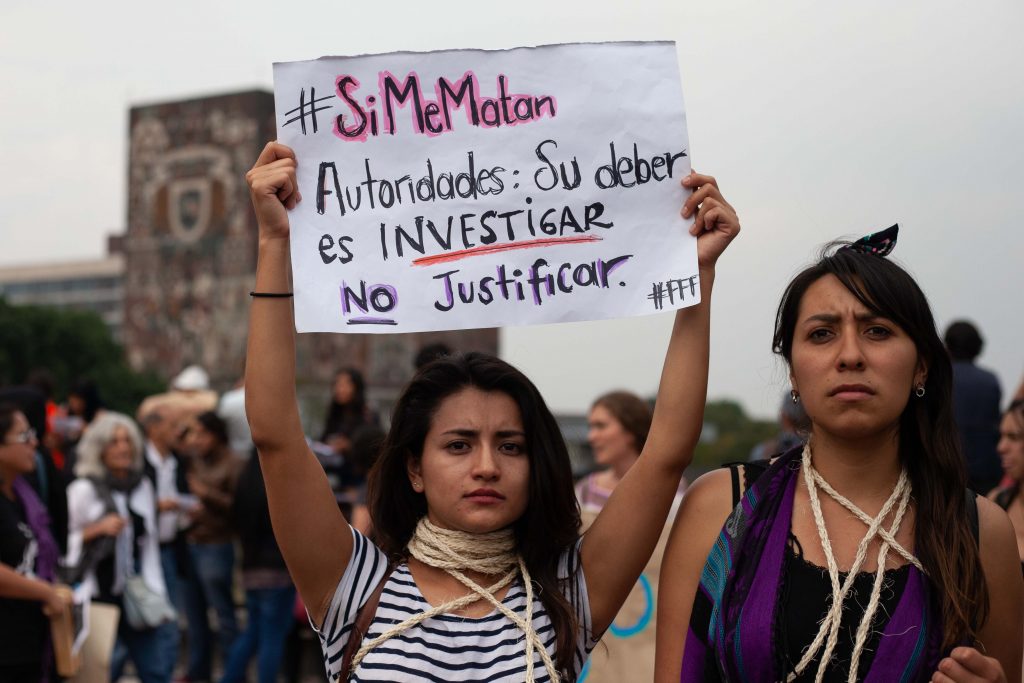
Featured images courtesy of a Knoll Soloff, Andalusia, Latin America, News, Women’s Issues, 10 May 2019.
Translation: “#iftheykillme Authorities your duty is to investigate not justify” by Student during a protest after the death of Lesvy Berlín Rivera Osorio.
Featured images courtesy of a Knoll Soloff, Andalusia, Latin America, News, Women’s Issues, 10 May 2019. #SIMEMATAN began a way of expression of millions of women on Twitter and in social media to say no more to the femicide in Mexico and Latin America. Journalists, artists, and famous manifested identified with the movements, and join them with their writings, music, and some twitters around the world. Some examples are:




On May 2, 2019, the titular of the head of the Mexico City Attorney General’s office (PGJDF), Ernestina Godoy, apologize to the family for “declaring her death as suicide with any proof that all”. Lesvy’s mother, Araceli Osorio, deserve it but it is not enough to heal all her pain and the millions of women have suffered, in the conference, she added that: “we aren’t going to keep only our eyes in you, we are going to keep all our senses to defend women’s life rights”.

De CrisCastilloVel – Trabajo propio, CC BY 3.0, Marcha en la -UNAM contra -feminicidio de -Lesby, Wikipedia, https://commons.wikimedia.org/w/index.php?curid=58623426
Millions of incidents like these occur daily in Mexico, Colombia, Argentina, and many countries around the world. Labels like
#SiMeMatan -#IfTheyKillMe
#NiUnaMas- #NotOneMore
#NiUnaMenos- #NotOneLess
#VivasNosQueremos- #AliveWeWantUs-
#ParenDeMatarnos — #StopKillingUs
#ElEstadoesResponsable — #TheGovtisResponsible
#ParoMundialdeMujeres — #WorldwideWomensStrike
#AbsoluciónaHigui — #AcquittaltoHigui
#LibertadMilagroSala — #FreeMilagroNow
Are the representation in social media, in banners, in songs, in paintings, in Graffiti, in streets, in news, in the life of many mothers, daughters, students, artists, singers, and dreamers.
Songs as “Cancion sin Miedo” —“SongWithoutFear” by Vivir Quintana ft. El Palomar, becoming a hymn for feminists and Expression of the pain and indignation of every woman violated, force, tortured, outrage, stripped of herself.
Every country has taken this song and shaped it with their women, with their fighters. This song has resounded in the hearts of many women and is a representative song against corrupt governments, and a call to speak up, and loud.
Another representative song is “Si Me Matan (If They Kill Me)” composed by Silvana Estrada, characterized by her “poetic style”, composing to love, freedom, sacred, life, justice, lose, and reunion. She wants to join every woman as a sister, and the fear is something that all of us overcome.
She published “trying to calm the painful and enormous wound that gender violence leaves us every day in our country and the world”. She mentioned that writing this song took her a lot of time to achieve because she wanted to find a way to compose a healing song for herself and others.
In her music video in collaboration with PRIM Public Project, (a historic space where union, culture, and creativity are celebrated – about PPP, Proyecto Publico, https://www.proyectopublicoprim.com/aboutppp) she mentioned that “in Mexico, more than 10 women are murdered per day”, a very worry and the scary number of deaths, most of them are not clarified until the date.
At the beginning of the song, you can see an empty, and abandoned building with a sensation of peace and loneliness, Silvana is sitting in front of different women of different ages.
She began singing: If they kill me
If they kill me,
when they find me
may they always say
may they always say?
That I was a singer,
living dreams.
That, like everyone,
I grew up with fear.
And, even then,
I went out on my own
to see the stars above,
to go for a sunny stroll.
And, even then,
I went out on my own
to see the stars above
to love life, love.
If they kill me
if they find me,
cover me in flowers,
cover me with earth.
For I shall be a seed
for the ones who come behind,
we are no longer silent,
nothing holds us back.
And let the songs be heard
like a warm mantle
healing the wound
of what we’ve lost.
That a cry, like thunder,
grasps us out of the grief.
They’ve taken so much from us
They’ve taken away our fear.
May hope prevails,
just like the sky is blue.
Looking at each other’s faces.
Sister, I love you.
translation by Paulina Duran.
All the women presented cry, even when I listened to her, I feel the pain and fear, that every Latin American woman carries, is released. we have been afraid, a lot… but now that they have taken so much from us, we can no longer allow them to take away from us out of fear the most precious thing that we have: life.
Silvana got to show the vulnerability transformed now in union and strength. she praises the women’s dreams and lives. this is so joyful; every single woman that has felt fear now feels understood. Every single effort to go out alone, walk late to home, or be driven by a stranger is now worth and sing of the fortress. Silvana gets her target of “soothe the painful and enormous wound” that femicide cause.
RESOURCES:
Original song- Silvana Estrada, Si Me Matan, YouTube, https://www.youtube.com/watch?v=oeU7rb-dBow.
Si Me Matan – Silvana Estrada (Lyrics Esp & Eng), https://www.youtube.com/watch?v=SirZ_TT5AzE, YouTube, 4 May 2021,
“Si me matan” de Silvana Estrada una revolucion con esperanza, https://rollingstone.com.mx/si-me-matan-silvana-estrada-entrevista/, ROLLING STONE MEXICO, 24 March 2021.
Instituto Interamericano De Derechos Humanos, http://www.iidh.ed.cr/multic/default.aspx?Portal=IIDH,
IIDH.
Meow, MAG, Por Olivia Meza de la Orta, https://meowmag.mx/el-canto-de-esperanza-y-fuerza-de-silvana-estrada/, 15 March 2021.
Knoll Soloff, Andalusia, If They Kill Me, Latin America, News, Women’s Issues, https://www.latinousa.org/2019/05/10/iftheykillme/, 10 May 2019.
#SiMeMatan, Twitter, https://twitter.com/search?q=%23SiMeMatan.
Feminicidio de Lesvy Berlin, Feminicidios en Mexico, Wikipedia, https://es.wikipedia.org/wiki/Feminicidio_de_Lesvy_Berl%C3%ADn, last date edited 3 dic 2021, 01:35
PPP, Proyecto Publico, location General Prim 30, 32 & 34, Col. Juárez, C.P. 06600, CDMX, https://www.proyectopublicoprim.com/aboutppp.
Queen of Soul Fights for Civil Rights – First Draft
Sarah Arzberger
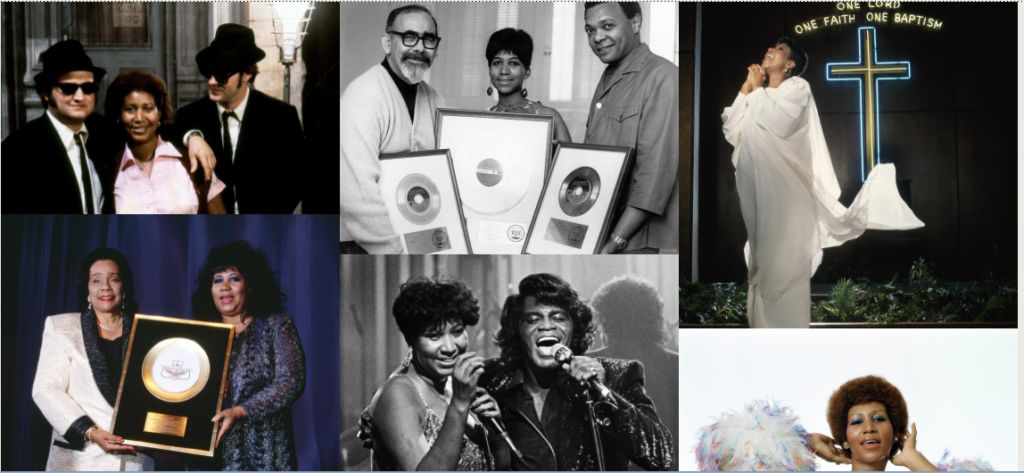
The legendary Aretha Franklin was born March 25th, 1942 in Detroit Michigan. She is best known as the Queen of Soul. Some of her accomplishments are 18 Grammys, the first woman in the Rock and Roll Hall of Fame, 73 songs that charted in the Hot 100 (a record that lasted 40 years), her voice was deemed to be a natural resource and was inducted into the Michigan Women’s Hall of Fame. But not only was Aretha a music icon, but she also used her talent and platform to help fight in the Civil Rights Movement. Dr.Bernice King called Franklin a “Shining example, of how to use art to support social change.” It’s not a surprise that she would become involved with the Civil Rights Movement because her father Clarence LaVaughn Franklin was close friends with Martin Luther King and was the one who orchestrated the 1963 Detroit Walk to Freedom which is the second-largest demonstration for civil rights in the US. As a teenager, Aretha would sing in the choir at her father’s Church and at 14 she released her first gospel album. At the age of 16, she went on tour with Martin Luther King which she would sing Gospel Music. It wasn’t until the 1960s when she was 18 did she transition from sacred to secular music with her father’s blessing. It wasn’t long after that she started producing hit after hit.
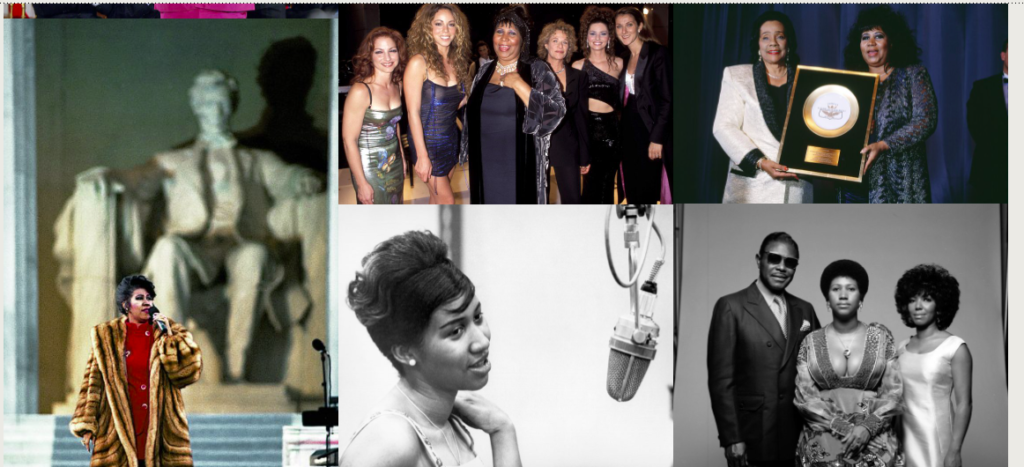
“R-E-S-P-E-C-T, find out what it means to me” is A classic, a hit, an anthem, and one of the most well-known songs on the planet. Respect by Aretha Franklin is a song where you read the lyrics and the tune starts to play in your head. For me, I know the song Respect as the song that taught me how to spell the word respect but it’s actually an anthem for the racial and gendered political movement. The song was originally written and recorded by Otis Redding in 1965 but had a completely different meaning. The meaning of the song was from a male perspective. Otis sings about how he should have respect from his women when he returns home after a long day at work. He uses names like a little girl, baby, and honey. And mentions how all the money goes to her but there is no respect. Aretha then takes Otis’ song and turns it upside down. She said “Well, I just love it. Of course, that became a mantra for the civil rights movement. ‘Respect’ is just basic to everyone: everybody wants it […] Everybody wants and needs respect. It’s basic to mankind. Perhaps what people could not say, the record said it for them.” In 1967 Respect became an anthem of the Civil Rights campaign and Feminist Movement. In 2016 Aretha told Elle Magazine “she was stunned by its success and it was the right song at the right time.” One thing I found fascinating was it didn’t matter how famous Aretha became she never lost sight of her sense of activism. It was in her contract to never play to a segregated audience. Not only did her music shine a ray of light on the Civil Rights Movement but also helped with musicians seeking royalties. The New York Times article “ How Aretha Franklin’s ‘Respect’ Became a Battle Cry for Musicians Seeking Royalties”, states that “In recent years, “Respect” has also become a battle song in a fight over digital rights. Laws passed in the 1990s let performing artists collect royalties from internet and satellite radio, but songs were exempt if they were recorded before a change in federal copyright law took effect in 1972.” This is just a prime example that Aretha Franklin not only helped during her time but her music, later on, got to help other musicians obtain royalties for their music.
Besides writing amazing hits and anthems, Aretha helped support the Civil Rights Movement in other ways. She played and held free concerts, paid for many Civil Rights tours and campaigns while Martin Luther King jr was alive, and housed activists and helped them fundraise. Many would say that she was not just an entertainer but an inspiration. According to Quartz web article “When Aretha Franklin Offered to Post bail for Angela Davis” states “reporting her intention to post bail for the black power activist Angela Davis, who was being held in prison in connection with the escape attempt of prisoners from a California courtroom, in which several people were killed. (She would eventually be acquitted.) At a time when Davis was called a “dangerous terrorist” by President Richard Nixon, Franklin didn’t hesitate to risk her reputation and money to support the now-legendary civil rights activist.” Whether it was $100,000 or $250,000 Aretha Franklin did not care and just wanted to do what was right despite what others would think, especially her father. Aretha said My daddy (Detroit’s Rev. C.L.Franklin) says I don’t know what I’m doing. Well, I respect him, of course, but I’m going to stick by my beliefs. Angela Davis must go free. Black people will be free. I’ve been locked up (for disturbing the peace in Detroit) and I know you got to disturb the peace when you can’t get no peace. Jail is hell to be in. I’m going to see her free if there is any justice in our courts, not because I believe in communism, but because she’s a Black woman and she wants freedom for Black people. I have the money; I got it from Black people—they’ve made me financially able to have it—and I want to use it in ways that will help our people.” Throughout her life, Aretha Franklin remained a prominent voice and face for African American Civil Rights.
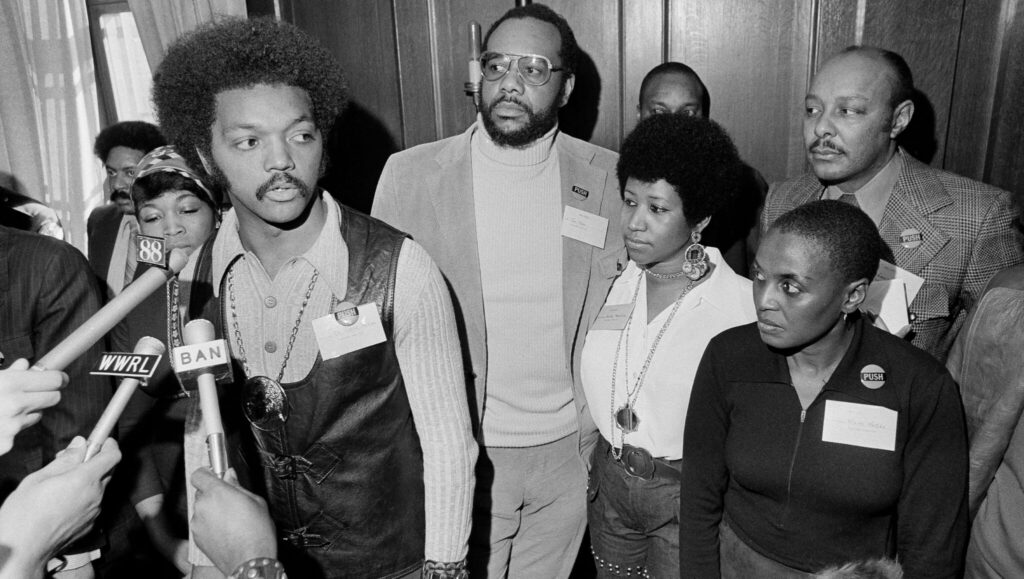
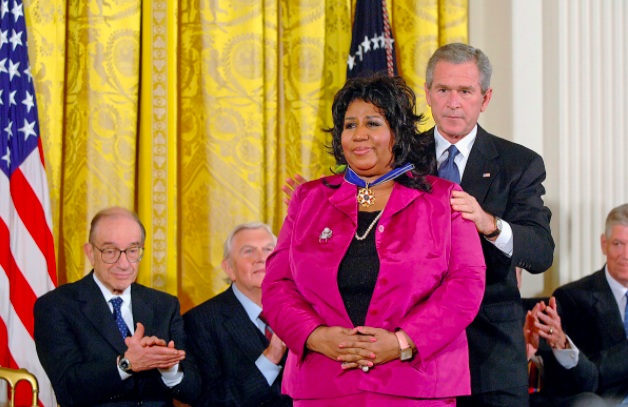
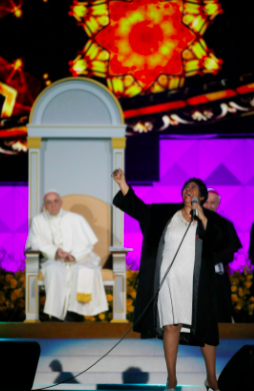
August 16, 2018, is a day that the world lost a legend. Unfortunately, Aretha Franklin passed away from an illness in her pancreas at the age of 76 in Detroit Michigan. Although she may not be here, her music will keep her spirit alive. One of her close friends, President Barack Obama said “Aretha helped define the American experience. In her voice, we could feel our history, all of it and in every shade—our power and our pain, our darkness and our light, our quest for redemption and our hard-won respect. May the Queen of Soul rest in eternal peace.” Everyone remembers Franklin’s work in the music industry but her work in the Civil Rights Movement has changed the world and helped so many people. That is why Aretha Franklin’s art has helped make a huge difference in many different movements.
Work Cited
BBC. “Aretha Franklin: The Sound of the Civil Rights Movement.” BBC News, BBC, 16 Aug. 2018, https://www.bbc.com/news/world-us-canada-45216581.
Josephs, Brian. “Aretha Franklin Rose with the Civil Rights Movement.” Billboard, 6 Sept. 2018, https://www.billboard.com/music/pop/aretha-franklin-civil-rights-movement-8470735/.
Lang, Cady. “Aretha Franklin Had an Impact on the Civil Rights Movement.” Time, Time, 16 Aug. 2018, https://time.com/5369587/aretha-franklin-civil-rights/.
Merelli, Annalisa. “When Aretha Franklin Offered to Post Bail for Angela Davis.” Quartz, Quartz, https://qz.com/quartzy/1356841/when-aretha-franklin-offered-to-post-bail-for-angela-davis/.
Ritz, David. “Aretha Franklin.” Encyclopædia Britannica, Encyclopædia Britannica, Inc., https://www.britannica.com/biography/Aretha-Franklin.
Williams, Gracie. “The Story behind the Song: Aretha Franklin’s Mega-Hit ‘Respect’.” Far Out Magazine, 28 Apr. 2021, https://faroutmagazine.co.uk/aretha-franklin-respect-story-behind-the-song/.
AIDS Awareness
John Navarria
AIDS Awareness is an event that raises awareness towards AIDS/HIV every year on April 10th. My goal is to spread more awareness by emphasizing projects made by thousands of people ranging from the AIDS memorial quilt, paintings, to online galleries dedicated to archiving artwork.
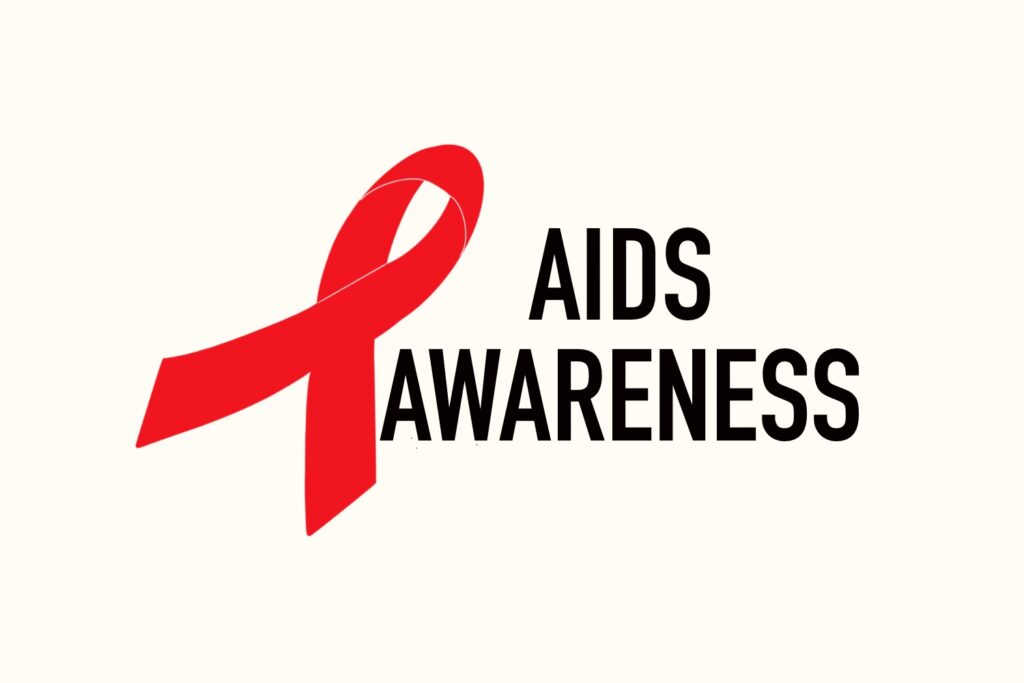
AIDS created a lot of stigma and discrimination towards LGBTQ people. Some believed that only certain individuals could get HIV and those who got it deserved it for being gay. These rumors kicked off in San Francisco during the 1980s. The first articles about the virus published by the CDC talked about how 5 previously healthy, young gay men had got it and unfortunately lost their lives to it. As a result of the article US gay rights movements were severely frowned upon. People began to become less comfortable around gay men specifically. Even the government at the time was devoted to funding resources for gay movements. With a new virus and increased amounts of tension between the LGBTQ community, something had to be done.
In this section, I’m going to be talking about the AIDS Memorial Quilt. We learned briefly about this topic in class but there is still a lot more to know. The project was started by Cleve Jones, a social activist, who dedicates his time to spreading positivity through artwork. Jones was born in West Lafayette, Indiana on October 11th, 1954. Jones first got into social rights movements when he was “adopted” by gay rights leader Harvey Milk. Jones had worked for Harvey Milk as an intern until he was assassinated in 1978. It was not until 1983 that Jones founded the AIDS Memorial Quilt. The idea of the quilt came to him during the candlelight march in remembrance of Harvey Milk and former Mayor George Moscone. At the march, people were writing names of those they lost to AIDS/HIV on signs. These signs were attached to the San Francisco Federal Building. Jones used what he saw that day as an inspiration.

The AIDS Memorial Quilt made its first appearance at the national mall in Washington DC on October 11th, 1987, at the same time as the National March for Lesbian and Gay Rights. At the time, the quilt had over 1900 panels and was the size of a football field! The first showing of the quilt lead to every name being read at all the future displays. Over 500,000 people had visited the quilt during its first showing. The textile art was so popular that the quilt toured over 20 cities. Over 9,000 volunteers helped the quilt be displayed across the country. Every city that was toured just made the quilt bigger and bigger. Towards the end of the first tour, the quilt was just over 6,000 separate panels. In November 1989 the quilt made its last stop at the National AIDS Memorial where it still resides In San Francisco. The project itself was made to stop the hate and social misconduct towards people affected by the virus. The quilt inspired so many more projects on over 5 different continents. As of recently a new project called “Call My Name” was started to remember black lives lost to AIDS. This project as well as the AIDS Memorial quilt can now be toured online in its website exhibit!
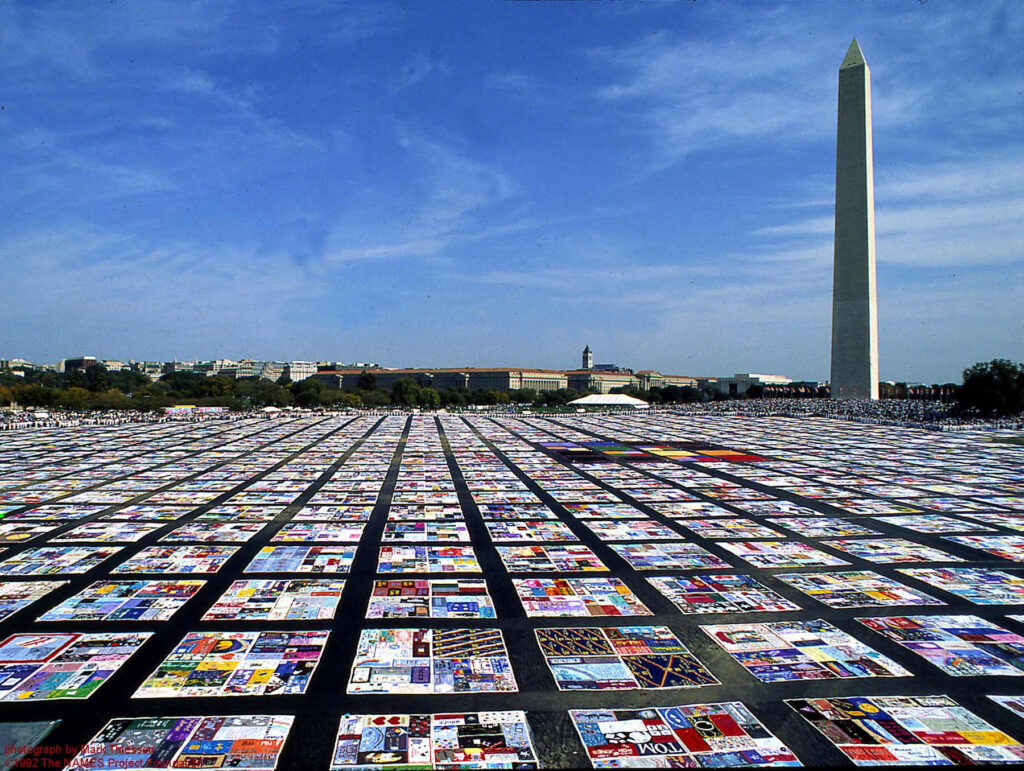
Another artist I will be talking about is Frank C. Moore. A lot of Moore’s artworks were focused on civil rights and environmental problems. What you may not know is that Moore himself was diagnosed with HIV in 1985. Following his diagnosis, Moore began creating artwork pursuing AIDS awareness and homosexuality. Later in 1988, Moore became a founding member of the program called “Visual AIDS” a project that utilizes art to fight against AIDS by preserving art and spreading awareness. The program continues to raise awareness to date. Shown below are some of Moore’s art as well as art from the Visual AIDS web gallery.

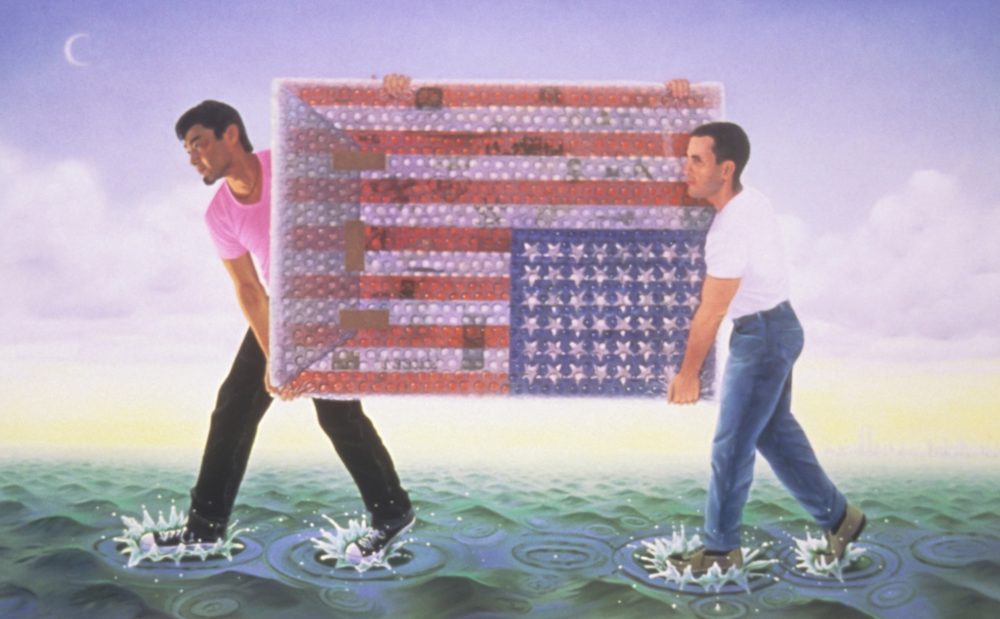
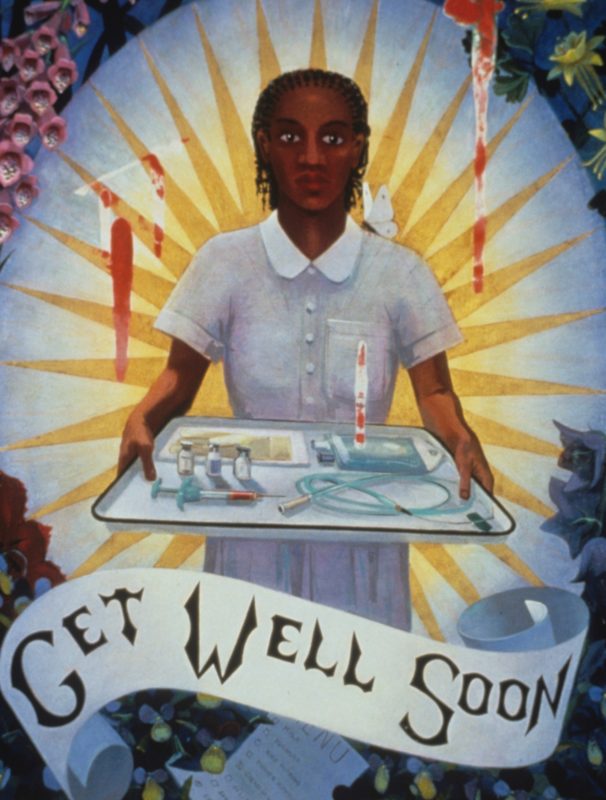
Although AIDS Awareness has influenced millions of people to actively work together and spread awareness through paintings, textile artwork, and online art galleries, we still do not have a proper vaccine for the virus. A ton of my intention and motivation to write about this issue came from the AIDS memorial quilt. This shows how much artwork can bring social issues to light. I have faith that in the upcoming years with the increasing numbers of the LGBTQ community that we can finally put a stop to the discrimination and hate caused by the virus.
Sources:
https://www.clevejones.com/ – Founder of the AIDS Memorial Quilt.
https://www.aidsmemorial.org/quilt-history – History of the quilt.
https://www.aidsmemorial.org/virtual-quilt/virtual-quilt-black-history – Call My Name Movement.
https://visualaids.org/
https://www.davidzwirner.com/exhibitions/2021/more-life/frank-moore
:)
By: Ryan Smith
From day to day out, women are being told to smile and look a “certain way” to appease men for their self-worth. But these opinions that men have about women are nothing but objective and disrespectful to the fullest. You see it happen on the streets, subways, stores and virtually anywhere people are interacting. This has been an ongoing issue that’s seen a worldwide pandemic within social change.
This brings me to a brilliant social street artist by the name of Tatyana Fazlalizadeh. This movement started here in the ever-growing city of Brooklyn, New York in 2012. You’ll see portraits put up around various locations in the city of actual women that have been interviewed for this project with quotes such as “MY WORTH EXTENDS FAR BEYOND MY BODY”, “I AM NOT HERE FOR YOU” and “YO MEREZCO SER RESPETADA” which translates to “I Deserve To Be Respected”. By making her work in multiple languages she’s able to reach a larger audience of the general public and therefore get her voice out there. Behind each of these portraits has a larger story and their own experiences that each woman holds near to themselves. They shared what it’s like to have these daily experiences with harassment and how daunting it can take a toll on oneself.
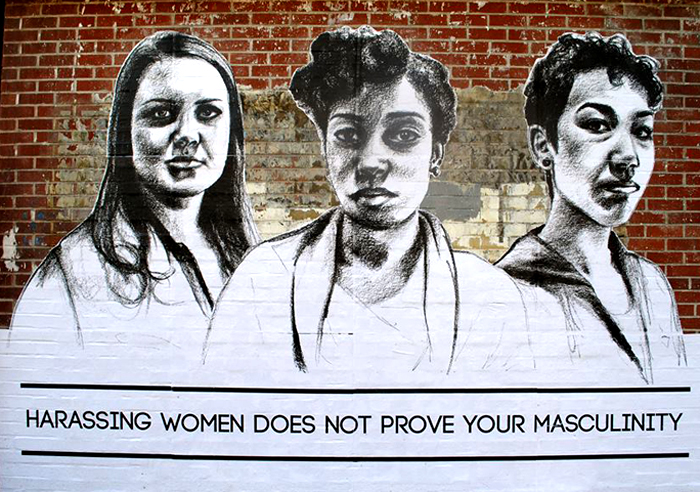
After starting only 10 years ago this ever-growing social change has reached far-off places around our earth. These brave women’s stories are being told in New York, Berlin, France, Canada, Mexico, Trinidad, and the UK. It wasn’t until 2015, that Fazlalizadeh took this project to Mexico, making it international. It was the first step into bringing this movement worldwide and expanding her voice to the ends of the earth. Two years later she brought Stop Telling Women to Smile to her home state of Oklahoma, which is a primarily Republican state in wake of the 2016 election of Trump. The text read “America is black. It is Native. It wears hijab. It is Spanish speaking tongue. It is migrant. It is a woman. Has been here. And it’s not going anywhere.” That piece being in a republican state spoke volumes and raised an uproar, but she stuck to her guns and stood her ground. Her tenacity didn’t stop there, she brought in another groundbreaking movement in 2020 where her murals portraying exquisite portraits of Breonna Taylor, Atatiana Jefferson, Tony McDade, and Nina pop in New York City. These portraits raised awareness addressing Racial and Transphobic violence happening today.
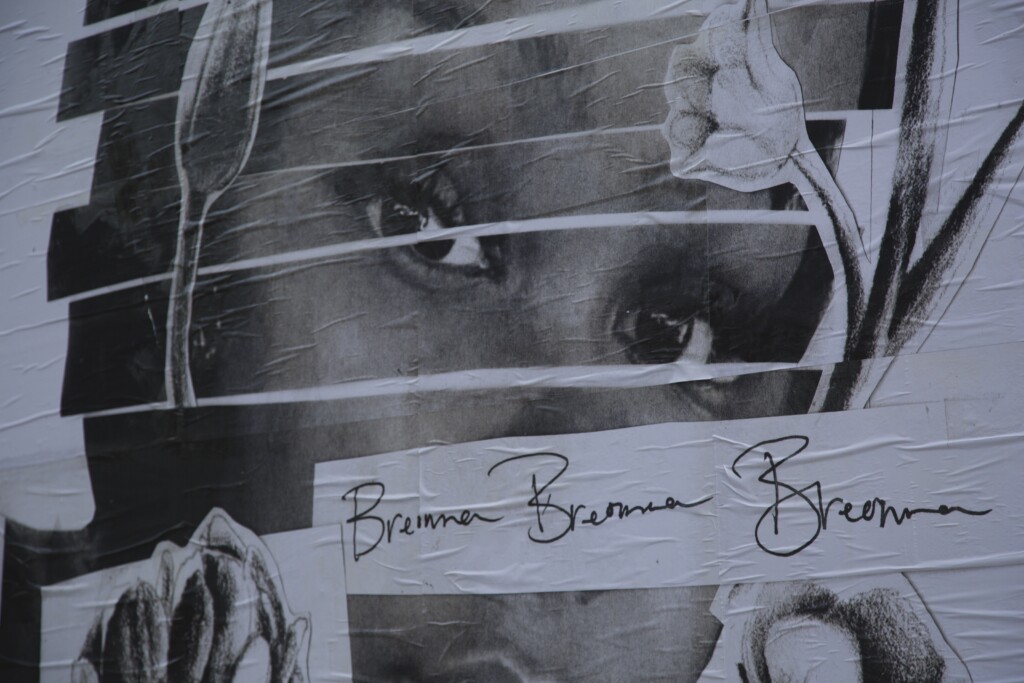
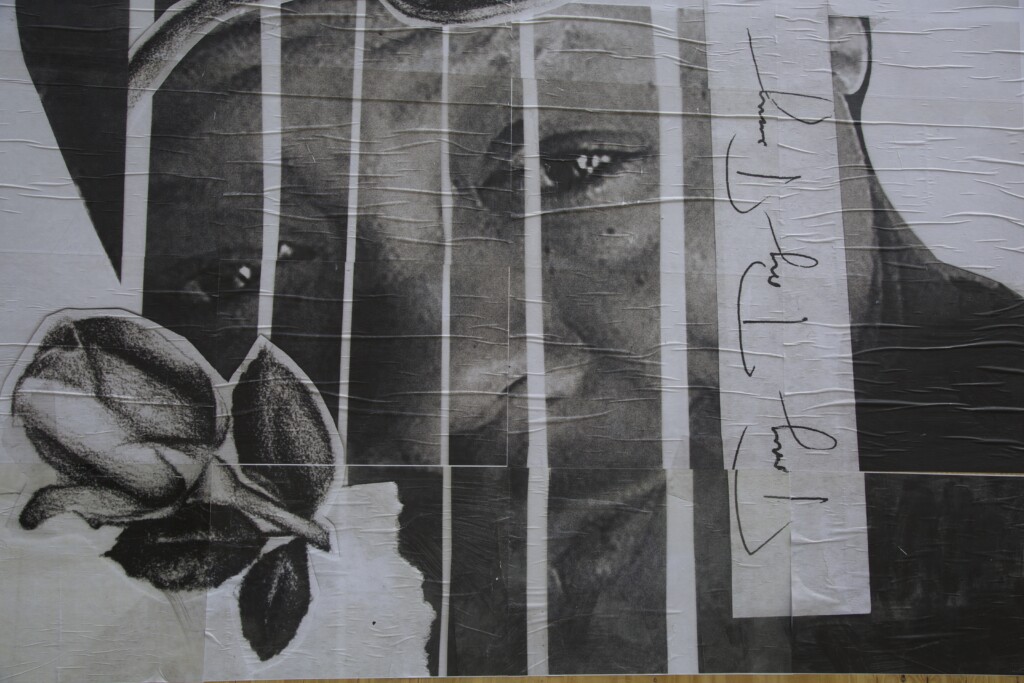
That just goes to show how many social issues there are and how it affects so many people from so many different walks of life. It shines a spotlight on the fact that no matter where you reside, the similarities of harassment are jarring enough for women to all resonate with and have similar stories. There are countless individuals, including myself that have the utmost respect for Fazlalizadeh and the dedication it took for her to get her voice out there and help so many other women voice their opinion on what’s been happening.
As the project is titled “Stop Telling Women To Smile”, it goes far beyond just that, but furthermore, it dives into the fact that just because a woman might wear a specific outfit that doesn’t give any man or person the right to an invitation to them or any unjust opinion. Women should be to wear and do anything in this world that they so do please without the constant harassment from men who seem to believe they have a right to voice their own opinion when in fact they should know their place and show these women the respect that they so rightfully deserve. From having countless women as friends, I’ve heard stories about how just walking from the train station to work here in New York City, they would get unnecessarily cat-called from men. The amount of disrespect and harassment that these women must feel daily is downright horrific and heartbreaking. No one should have to endure such an uncomfortable feeling when they are simply trying to go about their day.
This movement not only shines a light upon this worldwide pandemic amongst women but also hopefully a step in the right direction as an entire society in the fact that we owe it to ourselves to treat women with more dignity and respect regardless of the circumstance. As men, we truly don’t understand the pain these women endure and have to face when out in public but what we can do is stand up for what’s right and lift women and give them the respect they deserve.
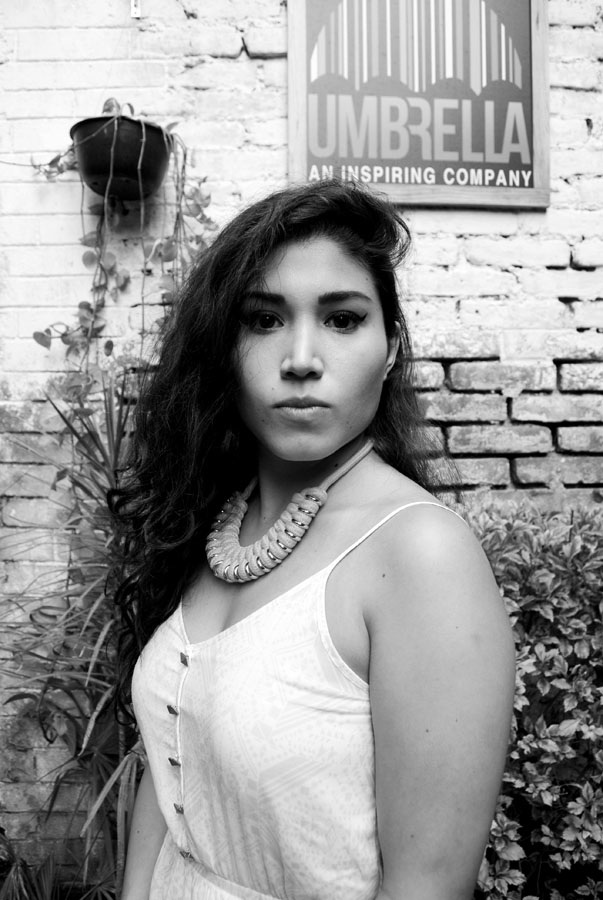

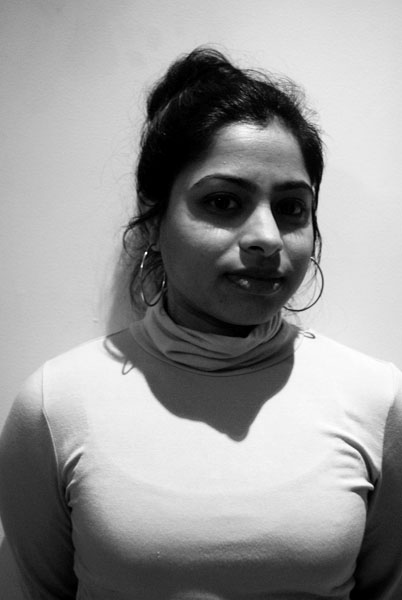
Lee. R, Felicia. “An Artist Demands Civility on the Street With Grit and Buckets of Paste.” The New York Times, 9 Apr. 2014 https://www.nytimes.com/2014/04/10/arts/design/tatyana-fazlalizadeh-takes-her-public-art-project-to-georgia.html
Fabulize Magazine, Contributor. “It’s Important For Men to Understand That They Need To Stop Telling Women to Smile.” 11 April. 2016 https://www.huffpost.com/entry/its-important-for-men-to-stop-telling-women-to-smile_b_9655246
Lambkin, Kelly and Cortland, Suny. “2 New York Artists Who Used Graffiti to Ignite Social Change.” 15 Nov. 2017 https://studybreaks.com/culture/graffiti-ignite-social-change-new-york/
Fazlalizadeh, Tatyana “Stop Telling Women to Smile.” www.tlynnfaz.com
About “Si Me Matan” By Silvana Estrada (If they kill me)
Liz Cortes
I decided to choose The music of Silvana Estrada a Mexican Spanish that sings against violence in Latin America and at the same time the superficial idea of love in the society that denigrates the respect for women and those who identify with it.
I believe I could find a lot of movements around the world, but this one connects with me, and millions of Latin American women, that have had to overcome trauma since childhood, social fear, violence, murder, stereotypes, and disrespect in all types of relations.
Is kind of difficult to completely introduce her idea because their songs are written in Spanish, but I am sure that even without knowing the language a good song could be appreciated.
“Si me Matan” is a song that speaks about the fear of women going out on the streets. This fear has been fed generation by generation, for grandmothers and mothers. They teach you that you shouldn’t get out showing any part of your skin, or something tight. You should walk far to the walls in case a man comes don’t corner you against it or the idea that a woman has to abide a disrespectful partner.
Without a doubt, I would like to share a little about what this fear is and how thousands of women and movements have risen up against it. In addition, shows, how Silvana Estrada creates a song of consolation and political call to the Mexican government on the incubation of illegal and violent acts against women.
https://popnable.com/mexico/songs/430858-silvana-estrada-si-me-matan/lyrics-and-translations
her perspective about her music in society – https://www.elespanol.com/mujer/actualidad/20210706/silvana-estrada-enfermedad-siglo-liquido-cantar-desamor/594190932_0.html
Unit 2 Proposal
For my Unit 2 proposal, I will like to focus on one of the most infamous events to occur in Mexico, the disappearance of 43 Ayotzinapa Normal School students on September 26, 2014. This event has left many families angry at the Mexican government because as of today, they are still not found and are blaming the very government for being responsible for it. I remember the first time watching and hearing this on TV in 2014 and found it disturbing that such an event happened. My family comes from Mexico and feel that it is no surprise that the Mexican government chooses not to solve this action, given to possible corruption in the government.
As I was searching more information on this event, I came across images such as photos, paintings, and other form of arts like banners done by a group of Mexican artists. According to the short bog post, the banners are there to serve against ” a climate of fear surrounding protests in the wake of kidnapping”. There have been cases of protests against the government and the fear of retaliation. Some of the art also serves as a form of inspiration and hope that one day these students will reappear alive and well.
Terms to Research
Ayotzinapa
43 students
Fear of Protest
Police Violence
Mexican Artists Resurrect Ayotzinapa 43 in Protest Art
Mexican Artists Resurrect Ayotzinapa 43 in Protest Art
Missing Students in Mexico Have Inspired a Wave of Protest Art
DUE DATES
THE END IS NEAR. The end of the *semester.* Don’t freak out.
That said, there’s some things we need to plow through. Here’s how we are going to make it work:
All deadlines listed are 11:59 pm
FRIDAY 11/26 — Unit 2 Draft submitted via Blackboard
SUNDAY 11/28 – TUESDAY 11/30 Unit 3 live on Blackboard
THURSDAY 12/2 — Unit 2 Final POSTED ON OPEN LAB
11/29 Class = Final prep,
12/6 Class = Final prep, Unit 2 celebration
12/11 – 12/13 FINAL EXAM LIVE on BLACKBOARD
Unit 2 Proposal
Cult of Personality: Art and Propaganda in the DPRK By Angela La
For my Unit 2 thesis, I have chosen to dive into the world of graphics in the everyday life of the DPRK (Democratic People’s Republic of Korea, or North Korea). I would like to explore how artists express themselves despite the strict rules, and where to draw the line between art and propaganda, if that is even possible in a country like the DPRK. These propaganda posters serve as one of the main ways to communicate to the masses where internet access is severely restricted. To the outside world, it’s easy to see them as overly militaristic and anti-American, but there can also be a more nuanced message through art in a reclusive state.
Terms for research
Kim Jong Un
Pyongyang University of Fine Art
Art IS Propaganda in North Korea
Worker’s Party
Graphics from everyday life
Socialist realism
Sources
https://www.cnn.com/style/article/north-korea-propaganda-posters-design/index.html
https://www.lamag.com/culturefiles/north-korea-sun-mu-propaganda/